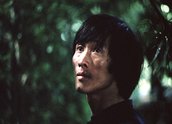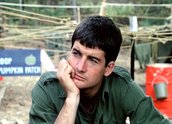


The Odd Angry Shot (1979)
Synopsis
After his 21st birthday, Bill (John Jarratt) goes to fight in Vietnam, as part of the Australian forces. He’s in the Special Air Services, elite professional soldiers who look down on the ‘nashos’, the conscripted troops. Bill’s best mate is the jovial and older Harry (Graham Kennedy), a likeable cynic. The rest include Rogers (Bryan Brown), Dawson (Graeme Blundell), Scott (Ian Gilmour) and later, Bung (John Hargreaves) – all young men who believe they’re fighting for their country.
Their daily life in camp consists of rain, beer, cards and bad food, punctuated by the sporadic excitement and terror of jungle patrols. Their numbers dwindle as their tour progresses, in a series of realistically portrayed skirmishes with the enemy. As the body count rises, Bill counts the days till he can go home, but to what? The welcome home is cold, as Harry predicted.
Curator’s notes
The Odd Angry Shot is one of the very few Australian films that deals with the Vietnam war, and it does so through the eyes of professional soldiers, rather than officers or conscripts.
It was not the Vietnam War movie that some Australian critics wanted or expected in 1979, although audiences liked it. It was popular then and continues to be revived, partly because it’s very funny, with an appealing cast of actors noted for their larrikin characteristics.
The film is based on a 1975 novella by William Nagle, which won a National Book Council award for Australian literature. Nagle died in the US in 2002 and there are conflicting reports about his military service. Some sources say he served in the US Special Forces from 1965 to 1968. The film’s producer, Sue Milliken, has said she originally thought he was in the Australian Special Air Services (SAS), but he turned out to have been an army cook (see below). The novel deals with SAS regulars stationed at Nui Dat, and most of the irreverent humour in the film comes directly from the book.
The film arrived at a time when Australia’s involvement in Vietnam was still a raw public issue. The American war in Vietnam had ended only four years before and the movie was criticised by some for not condemning Australia’s participation in absolute terms, even though the issue is discussed (see clip three).
American cinema had begun a reassessment of the war in savage and rueful films like The Deer Hunter and Coming Home – both released in 1978 – and The Odd Angry Shot was not in the same mould. It was strong on larrikin humour and camp hijinks, which left it open to accusations that it treated the war as a lark. It was perhaps more accurate to say it sided firmly with the soldiers, and adopted their style of sardonic humour. That had long been a feature of Australian films about war, even as early as the 1930s (see Diggers and Forty Thousand Horsemen). It had been popular in British and American films of the 1960s (eg: The Virgin Soldiers and M*A*S*H). By the late 1970s, some Australian critics wanted something stronger and more condemnatory.
On the other hand, it was probably a more realistic portrait of an Australian soldier’s experience of Vietnam than any American movie could be – especially in its depiction of the boredom and camaraderie of life on the war’s margins. These troops are in a backwater of operations. There are hardly any Vietnamese in their daily life, no generals, and very little overt discipline. Death and killing are a feature, but infrequent. The only constants are the men they live with, so the film is about that fellowship, or what used to be called mateship.
The term mateship was already going out of fashion in 1979, but it was always popular with audiences, particularly in Australian war films. Gallipoli and Breaker Morant are both mateship films, although more preoccupied with their anti-British politics. The Odd Angry Shot, which precedes both of these, does not look for an external power to blame. Whatever its politics, its criticisms are aimed at Australia, notably the politicians who sent the troops, and the general public, whom Harry predicts will disown them on their return.
The film was made for $600,000, with full cooperation from the army and air force.
'It was a risky commercial venture making this movie in 1978,’ director Tom Jeffrey has said. ‘The Vietnam War was a dirty subject. Few people wanted to be reminded of our involvement. Remember the soldiers 'welcome home’ march didn’t happen until about seven years after the film was made. But I wasn’t making a conventional war movie. What I wanted to convey was soldiers as real people… Although the men are tough professionals, we focus on the human side of their lives. The film shows their courage, their fears, their loves and their humour – the full range of emotions shared and understood by everyone.’
Sue Milliken, the producer, has said: ‘(The novella) was written by a wild Vietnam veteran called Bill Nagle, whom we assumed had been in the SAS but eventually it turned out he had been an army cook. Nevertheless, a cook with an ear for the vernacular. The story was told from the soldiers’ point of view and was sardonically anti-war.
‘We made this film in 1978, which was only four years after the end of the war, so feelings were still very strong. The book said everything you needed to know about the misery and alienation of fighting a war which should never have been fought in the first place. It was also acerbic and funny, and it was this aspect of the piece, which we emphasised to wary investors as making the story accessible to an audience.
‘After months of perseverance, we got the cooperation of the army, although the army hierarchy was very nervous about anything to do with Vietnam. The soldiers, on the other hand, couldn’t have been more helpful. We shot for six weeks at the Land Warfare Centre at Canungra, in the hills behind the Gold Coast. The film is recognised by soldiers in all sorts of places around the world as one of the best films ever made about how a war is fought.’
- Overview
- Curator’s notes
- Video 3 clips

- Principal credits
- Find a copy
- Comments 1
- Map
- Reviews 1



